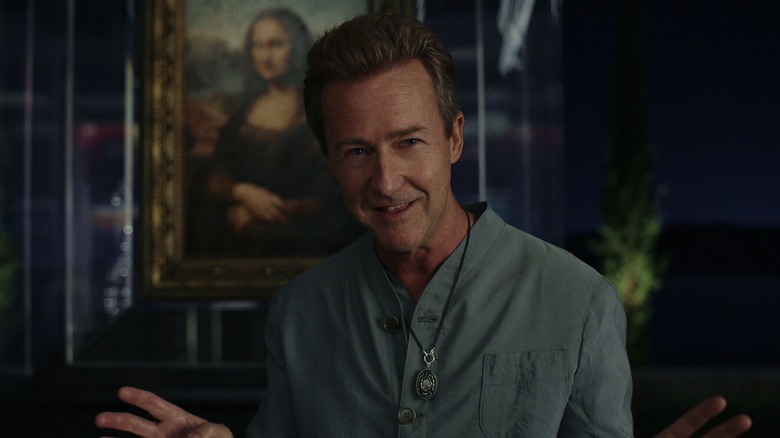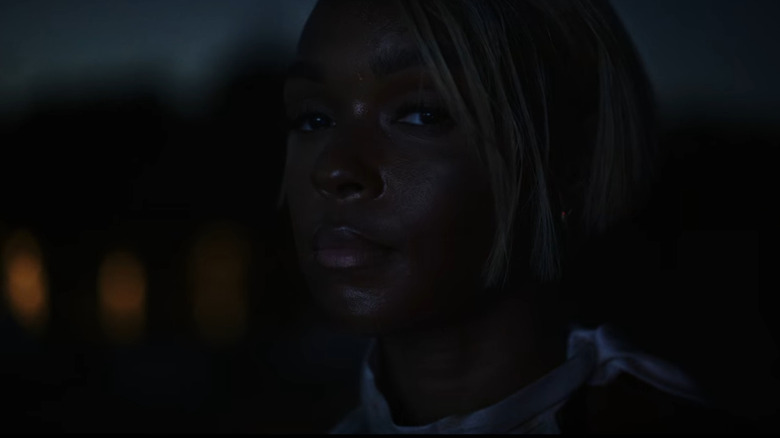Glass Onion Director Rian Johnson Explains The Significance Of The Big Mona Lisa Scene
This post contains spoilers for "Glass Onion: A Knives Out Mystery."
If you're a fan of Italian Renaissance paintings, your feathers may have been a little ruffled by the ending of "Glass Onion." When Helen (Janelle Monáe) realizes that she doesn't have enough evidence to get Miles Bron (Edward Norton) convicted for murdering her sister, she decides to get her revenge another way. First she starts breaking his stuff, then she causes a massive explosion that sets his mansion on fire. None of this is a huge deal for multi-billionaire Bron, but then Helen opens up the casing of the real Mona Lisa, and it burns up in the flames.
This is the nail in the coffin for Miles. The Mona Lisa is the most famous painting in the world, and almost certainly one of the most expensive. Not only will Helen's actions set Bron back a ton of money, but the damage to his reputation is insurmountable. If Elon Musk's net-worth declined as much as it did from his Twitter antics, imagine how much Bron's net-worth is going to plummet after the world's most beloved painting has been destroyed under his watch.
It's meant to be a triumphant moment in the story, but is it? For anyone upset over the movie's seemingly positive depiction of destroying priceless, beloved works of art, director/writer Rian Johnson gave a response in a recent interview with The Filmcast. "I don't think it would actually in real life be a heroic action to destroy the Mona Lisa," Johnson said, "but in the context of a movie with this tone..."
A triumph only in fiction
Ultimately, what makes the storytelling decision a good one in Johnson's eyes comes down to Helen's motivations for doing it, and the way it reflects Bron's own speech about disruption earlier in the film. As he put it:
"Miles himself says it with his disruptor speech. It's easy, to start breaking these little glass things ... you start breaking bigger stuff, people get a little apprehensive. The question is 'are you willing to break the thing nobody wants you to break?' ... You can't just break a more expensive chandelier; it needs to be something that creates exactly that effect in you, of 'I don't know how I feel about this.'"
For all Bron talks about wanting to disrupt the system, he and his friends are people who clearly benefit from that system and don't have any wish to see it destroyed. Their acts of supposed rebellion against the status quo are nothing more than them trying to grab more power and make more money. Burning up the Mona Lisa, meanwhile, is an act that actually is bold and impactful, which takes genuine audacity to go through with. (It's also a bit of a tragedy, but that's neither here nor there.)
As Johnson explained:
"The whole thing at the end was putting his words into action and using them against him, and him being actually horrified because he's full of s***; he doesn't want actual disruption, he doesn't want the system to be broken. That meant we actually had to go there."
Refusing to backslide
In an early cut of the film, there was a scene at the very end that revealed the painting that got burnt up wasn't the real Mona Lisa. It would've eased the blow for anyone who found its destruction upsetting, but after one watch through the film, Johnson decided to cut it. "Immediately I was like, 'No, this is pulling a punch, bulls***, this is dumb. Take it out,'" he explained. It's probably the right choice: if you're going to do something like this, it's best to go all in or not at all.
With its closing shot, the movie makes a final connection between the story it's telling and the famous painting it destroys. In those last moments, Helen looks at the camera with a similar pose and expression as the Mona Lisa, with that ambiguous face that could be a frown or a smile. It's a moment that seems to underline the movie's idea that destroying the painting is okay; it shows us that the beauty and ambiguity of the painting can still be found in real life, even if it's not quite the same.
Not only that, but this final homage helps remind us of the whole reason she destroyed it in the first place. In that final shot, it almost feels like we're not just looking at Helen but at her identical twin sister Andi, whose death is what kickstarted the plot of this entire story. Destroying a famous painting might be in bad taste, but the murder of an actual living person is clearly the far bigger tragedy. In its closing moments, "Glass Onion" makes it clear where it thinks our priorities should lie.
"Glass Onion" is streaming on Netflix now.

